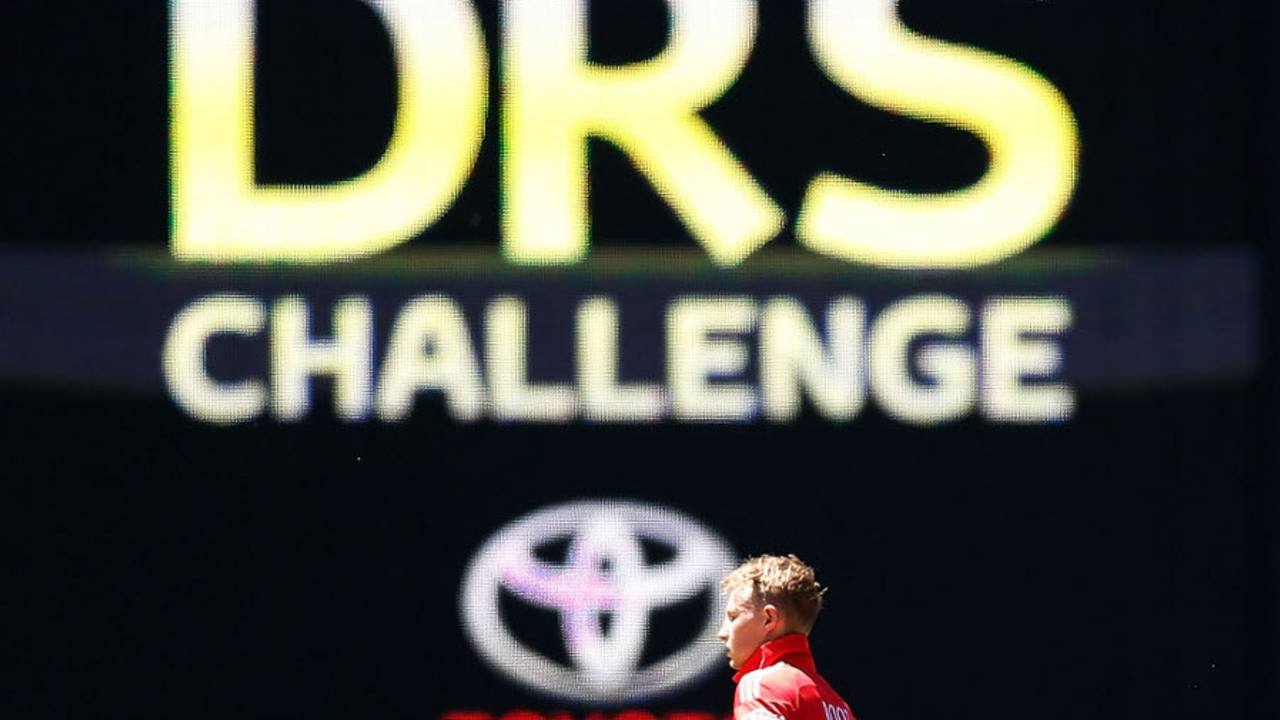Uniform DRS next challenge for ICC
The ICC is keen on having an edge-detection tool to go with the existing ball-tracking tool as minimum requirements for DRS
Alagappan Muthu
03-Nov-2016
DRS still has challenges aplenty • Getty Images
The ICC is keen on having an edge-detection tool - Realtime Snicko, UltraEdge or HotSpot - to go with the existing ball-tracking tool as minimum requirements for DRS. However, that depends on the ICC cricket committee headed by Anil Kumble, and a planned meeting with the member boards in February 2017 to "prepare a road map for the use of technology moving forward". For the ICC, the ideal outcome of the meeting will be some sort of agreement to have DRS for every Test no matter where it takes place, with the decided minimum requirements in place.
As it stands now, DRS is employed even in those Tests where no edge-detection technology is available whereas India have been playing without DRS even with the required technology available. That India have agreed to use it on a trial basis against England is a step forward, but ICC's general manager of cricket operations Geoff Allardice knows there is some way to go.
"I look at matches in different parts of the world, and I see the different levels of technology and you see umpires are left without conclusive evidence in one series where in another series they might have conclusive evidence with all tools available," Allardice said. "There are some logistical challenges as well about having every type of technology in every match but I think overall we should be striving for a more consistent delivery of technology at all international matches.
"Ball-tracking is standard in DRS at the moment, and we won't see that changing. I think you certainly need an edge-detection tool as a standard. If you go back to times gone by with the umpires listening to the stump microphone audio and trying to judge whether that was the sound of bat on ball or bat on pad or whatever, it was very difficult to make a decision [for the umpire] and also for the people watching at home to know what the umpire was thinking. And sound-based edge detection systems like Realtime Snicko and UltraEdge have simplified those kinds of decisions."
HotSpot is another tool that helps in edge detection, and while Allardice said it "has a lot to add to a DRS system", its inclusion posed "logistical challenges". India's home Tests against England, for example, could have had HotSpot but the BCCI was told it would take too long for the equipment to arrive in the country. The cameras used by HotSpot are high-end military cameras, whose shipping needs special permissions from governments.
The BCCI's opposition to DRS arose from a perception that it wasn't 100% fool proof. Some other boards do not employ it because of the high cost of equipment. As such there has been pressure on the ICC to assume control of the system itself. Allardice was open to the possibility.
"If we get the support of members for the ICC to take a greater role in providing consistent technology at every game, we think that's the right way to go forward. If we can map that out to the countries, and they like that, then the plan will be to start putting it in place." he said. "Generally in DRS series, we deliver 98 to 99% correct decisions, and what that does is provide a consistency of correct decisions, whether the conditions are difficult for umpiring, or whether the umpire is having a good day or a bad day."
There has also been protest against DRS because of the possibility of human error. When asked if the ICC might be interested in training people to operate the various technologies to assuage that concern, Allardice said it was the technology provider who was best placed to understand the nuances of the system and implement it correctly. He did, however, admit there was a need for the ICC to oversee operations.
"At this stage, I wouldn't see us wanting to be technology providers ourselves, because the expertise and product development work that's taken place over a long period of time, has been conducted by the technology providers. But I think there is a greater role for the ICC in the coordination of technology that goes to each match, and the oversight of the performance at matches."
DRS's impact on the umpires is also a point of debate. In the Chittagong Test between England and Bangladesh, eight out of 18 decisions made by Kumar Dharmasena were overturned. Allardice said the number of incorrect calls an umpire makes factors into his assessment by the ICC, but he is judged over a longer term than just one match.
"It's quite a test for an umpire in those conditions, because you can often be making good umpiring decisions that are later proven to be incorrect," Allardice said. "Like getting a glove on a sweep shot that then leads to an lbw being overturned.
"One of the skills of an umpire at all levels, whether there is DRS or not, is his resilience to mistakes. In the old days, you used to find out when you came off the field whether you had made a mistake or not, and now that feedback is a little bit more immediate. And being able to process feedback about your decisions, and then try to either use it to improve your decision‑making, or to not let it affect your decision making, is the thing that determines an elite umpire from the next level down."
Alagappan Muthu is a sub-editor at ESPNcricinfo
